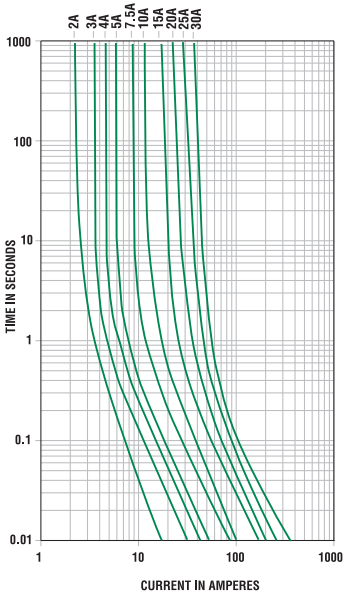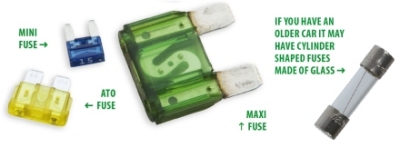Aolittel Technology Co.,Ltd |
|
Plug In Zinc Alloy Automotive Fuses Mini Auto Blade Fuse Rated
32VDC 20A Yellow 11mm For Automotive Passenger Car
Overview
| In | 1.1In | 1.35In | 2.0In | 3.5In | 6.0In | ||||
| 1-35A | >100Hours | Min. | Max. | Min. | Max. | Min. | Max. | Min. | Max. |
| 0.75 s | 1800 s | 0.15 s | 5 s | 0.04 s | 0.5 s | 0.02 s | 0.1 s | ||
Ratings
| Part Number | Ampere(A) | VoltageVDC | Body Color |
| AB11001 | 1A | 32V | Black |
| AB11002 | 2A | 32V | Lt.Gray |
| AB11003 | 3A | 32V | Violet |
| AB11004 | 4A | 32V | Pink |
| AB11005 | 5A | 32V | Tan |
| AB11075 | 7.5A | 32V | Brown |
| AB11010 | 10A | 32V | Red |
| AB11015 | 15A | 32V | Blue |
| AB11020 | 20A | 32V | Yellow |
| AB11025 | 25A | 32V | Natural |
| AB11030 | 30A | 32V | Green |
| AB11035 | 35A | 32V | Purple |


| Fast Acting, Low Voltage For UP To 32v DC | |
| Material | * Body: Plastic. * Metal: Zinc Alloy |
| Standard | According To SAE J2077 |
| To Permit More Fuses in The Same Amount of Space | |
| Fuses Are Color-Coded For Easy Amperage Identification. | |
Temperature Rerating Curve

Time-Current Characteristic Curves

How to Change a Car Fuse in 8 Easy Steps

Whether it's the rattling that comes and goes with the moon phases,
a timing belt that obeys only changes in barometric pressure, or
the sudden flickering of that dreaded check engine light, certain
car problems require the professional experience and honest
technical knowledge only a mechanic can bring. This doesn't mean
you should be afraid to approach your car with a tool though. There
are certain car fixes that every man should be capable of doing himself. Your mechanic might not thank you for
learning them, but your wallet surely will.
If you've never blown a fuse at home congratulations, you're an
anomaly. Fuses are designed to break as they prevent the
overloading of the whole system—think of them as the noble
sacrifices of the electrical world. Changing a fuse in your car is
similar to changing one at home.
1. Locate your car's fuse panel. You might need to check the owner's manual, but they can usually
be found under the steering wheel.
2. Take off the fuse panel's cover. Inside you'll see a range of colors and numbers that denote
different amperages while a diagram (usually on the reverse of the
cover) will show what each fuse powers in your car.
3. Locate the blown fuse. The inside will usually be black or the metal filament might be
broken. If it's dark, you might want a flashlight to make this a
quicker job.
4. Remove the broken fuse. You can use a variety of tools (or skip the tools and use your
hands) to extract the blown fuse, the important point is to use
care. Fuses can break easily and a broken fuse is a lot harder to
get out than a fully intact one.
5. Insert a replacement fuse of the correct amperage—make note of the fuse panel and your owner's manual on this one.
Using a fuse of the incorrect amperage can cause serious electrical
problems.
6. Keep a few extra fuses of various amperages in your glove box. In a jam, you can always take a fuse away from a lesser used
function of the same amperage and use it for something more
pressing, but this is just a temporary fix. For example, if the
fuse for your power windows is blown and there's no rain in the
forecast pull the working fuse that's allocated for your rear
windshield wiper and use it for power windows. Just double check
that the amperages for each are the same.

7. Start the ignition to check if your handiwork has paid off.
8. If the same fuse blows soon after you replaced it or doesn't work
at all, it might be time for a trip to the mechanic.

Step-by-step guide
 | Find the right fuse Use the car handbook or the lid of the fuse box to help identify which fuse you need to remove. |
 | Remove fuse: In the fuse box you should find a small set of plastic tweezers that make removing a fuse much easier. Simply slip them over the end of the fuse and pull it out. |
 | Check the fuse: If the fuse has blown, the thin metal wire that connects the two flat blades will be broken. |
 | Replace: Use the fuse tweezers to insert the new fuse. Make sure the fuse you are putting in is the same rating as the one you took out. |